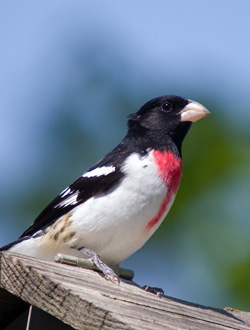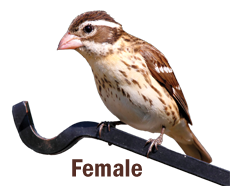Identification 
Simply put, there is absolutely no other bird that looks like the male Rose-breasted Grosbeak. The striking color patterns are distinctive. The female Rose-breasted Grosbeak looks nothing like the male. She is brown with white streaks and a white eye stripe. Rose-breasted Grosbeaks are in the same family as the Northern Cardinal. Notice their similar beak shape.
If you live in the northern part of the United States, you’ve probably heard their summer song and thought it was a robin, or maybe an oriole. They have a crystal clear, high warble.
Nesting
Both the male and female grosbeak sit on the eggs to incubate them. Located in trees, shrubs or even woven into vines, the nest is very loosely constructed of sticks, roots, hair, straw and leaves. Grosbeaks typically lay 1–5 eggs and it takes approximately 10–12 days for the nestlings to fledge.
 Range and Diet
Range and Diet
These grosbeaks are found only east of the Rockies, with their summer breeding territory ranging from as far south as as parts of Oklahoma and the Appalachians all the way up to Northern Canada. Oddly, they are not found in the Northeastern part of Canada. They winter in Central and South America. Rose-breasted Grosbeaks actually prefer second-growth forests, so their numbers are doing well.
Keeping a fresh water supply and black oil sunflower seeds is a great way to keep these birds in your yard all summer. Grosbeaks also eat large numbers of insects—consuming them similar to the way warblers do—and some fruit.

